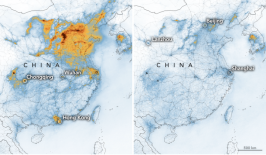In the initial stages of the coronavirus pandemic, there was extensive conversation about the impact of lockdowns on global carbon emissions. It was assumed, relatively early on, that the decline in air, maritime and road traffic could have a positive benefit on the environment, if only in the short term.
However, as lockdowns have extended and working from home has become the new norm for millions (around 26 percent of employees according to one study), research is now being conducted into the true environmental impact of our increasingly online lives.
One recent study investigating this issue was presented by the University of Michigan’s Grant Faber, a graduate student interested in the energy consumption demands of large online conferences. Prior to the lockdown, large business, governmental or trade conferences were frequently criticised for their carbon footprint, as hundreds of participants – and their staff – would converge in one location for a series of meetings or presentations. The issue was compounded by the fact many delegates coming would choose to travel by the most efficient forms of transportation – and not necessarily the greenest – and the conferences would usually only last a short time. Such conferences have now almost entirely moved online through video conference technology such as Zoom. But given the carbon emissions caused by our online activities, and streaming video in particular, are online conferences actually all that greener?
Faber’s study looked into a single conference held in May 2020 with around 200 researchers interested in carbon removal or sequestration. The group wished to investigate the climate impact of their online meetings and then purchase offsets to make it carbon negative. Information was gathered concerning the carbon emissions of the physical equipment that they used, such as computers, monitors and desk lights, as well as the online activities they carried out, including video streaming, search engine queries, website visits and pre-conference planning meetings.
Once all of this was tallied together, the report found that six hours of large Zoom meetings generated 1,324 kg of carbon dioxide emissions. That’s equivalent to driving almost 3,300 miles or burning 750 kilograms of coal. However, they were still much greener than traditional conferences, which on average can be expected to generate around 66 times more carbon.
In the case of this one conference, the majority of these emissions (64 percent) came from network data transfer, while only 11 percent came from actual computer use itself. This statistic is illustrative of the growing energy demands being placed upon the global information infrastructure – and the “carbon footprint” that we’re creating as a result.
More Data Needs More Power
Of course, it’s not only online video conferences that are causing an increase in the amount of data that we’re sending and receiving. Even prior to the coronavirus pandemic, more and more of our daily interactions were moving into the digital space. Video streaming platforms have seen a huge uptick in subscribers and demand, with 91 percent of Americans surveyed in one study claiming they were subscribed to at least one streaming service. This is especially true of younger audiences, who now spend just as much time watching content online, as they would with a traditional TV. And with video streaming being one of the most energy-hungry activities we can do online, we’ve even seen carbon offset schemes pop up, like Plantyflix, a subscription service that that invests your monthly payment in planting trees – to offset the estimated carbon emissions of your monthly Netflix use.
All of this data traffic places huge energy demands on global data centres, of course, the backbone of the modern internet. Data centres have extremely high energy demands both on account of their constant use and the cooling required to keep them functional. As more and more of our daily lives head online, more data centres and more energy will be required. According to one study, the number of internet connected devices is expected to triple from 10 billion in 2020 to around 30.9 billion in 2025. Furthermore, the roll out of high speed wireless internet connectivity, such as 5G, will also increase the demands of devices individually. Overall, internet data transfer could consume around 20 percent of global energy demands by 2030.
So, what can be done to alleviate this pressure? There are a few simple steps individuals can take to reduce their footprint, such as reducing the video quality of their streaming or making sure their homes – and with it, their electronic devices – run on renewable energy. Switching off video for online calls and fully turning off devices when not in use will also contribute.
On a larger scale, action is needed by states and technology companies to contain the explosion of digital energy demands. For example, manufacturers of computers and online devices could make sure that their products are more robust and less emission-intensive by design, in order to reduce the amount of e-waste. While the waste heat emitted by data centres could also be reused – for example to heat water. For their part, large technology companies have appeared to recognise the issue and some, such as Apple and IBM, have made carbon neutral or net zero promises. But for now, these tend to be examples of self-regulation, rather than directives that come from governments and lawmakers, which would of course be even more effective.
However, the most powerful strategy for reducing the emissions of virtual meetings would in fact be to decarbonise the electrical grid itself – or at least ensure that data centres are powered by green energy. According to Faber’s calculations, if solar had been used for conference-associated activities wherever possible, the overall emissions generated by the online event would have fallen by a huge three-quarters to only 344 kg of carbon dioxide.
Crossing the Digital Divide
However, the ongoing digitalisation boom will also have broader effects, including social impacts too. As digital media, apps and communication becomes more complex and demanding, it will also require people to have more expensive and advanced types of hardware in order to have access. The coronavirus pandemic has already exposed the growing issue of ‘digital poverty’ and the so-called ‘digital divide’ even within affluent nations, in the Global North – the inequality that exists within society when it comes to who can afford to access digital services. For example, according to a study by Cambridge University in the UK, only 51 percent of households earning 6,000-10,000 GBP a year have internet access, compared to 99 percent of those who earn over 40,000 GBP. Furthermore, certain apps or tools that make everyday life more convenient often require software updates not available on older or cheaper models of device.
So, while the benefits of moving infrastructure online could be significant, governments, private tech companies and individuals need to also be aware of the social and the environmental impact of this shift. Calculating these emissions and raising awareness about them is the first step in working to reduce them.







